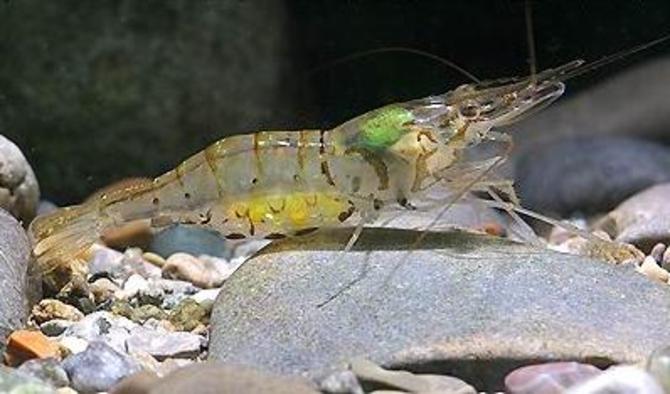
Whisker Shrimp

Little is known or documented about this shrimp species and will be updated as more information becomes available.
*Origin India
Common Name - Whisker Shrimp, Freshwater Prawn, Kuncho river prawn
*Temperature - 68F - 86F
*Foods Scavenger -- does fine on any fish food
*Decor - Likes a planted tank with sandy bottom
*Size - 2" - 3"
*Tank Size - Large tank not needed
*Personality - Seems more comfortable in groups
*Community - Not a predator. No large claws like many Macro species.
*Egg Incubation - Three weeks under female's abdomen
*Water - Moderately hard
*Reproduction - Lays eggs and has a short larval stage
Common Name - Whisker Shrimp, Freshwater Prawn, Kuncho river prawn
*Temperature - 68F - 86F
*Foods Scavenger -- does fine on any fish food
*Decor - Likes a planted tank with sandy bottom
*Size - 2" - 3"
*Tank Size - Large tank not needed
*Personality - Seems more comfortable in groups
*Community - Not a predator. No large claws like many Macro species.
*Egg Incubation - Three weeks under female's abdomen
*Water - Moderately hard
*Reproduction - Lays eggs and has a short larval stage

Macrobrachium lamarrei is a medium-sized freshwater prawn. The males can reach a total length of 80 mm (from the tip of rostrum to tip of telson) whereas, the females up to 75 mm. The body is usually creamy white to light brownish white with greenish brown pigmentation all over the cephalothorax. Like all species of decapod, prawns body consists of two distinct parts cephalothorax and abdomen. The carapace covers over the cephalothorax which is smooth and hard. The rostrum of this species is long reaching beyond the antennal scale. The rostrum is slightly slender. Dorsally rostrum bears 7-9 teeth and 5-8 below. The hepatic spine present on the anterior carapace margin. Five pairs of peraeopods, or true legs present in cephalothorax region. In contrast to the cephalothorax the segmentation of the abdomen is very distinct. This part possesses six segments where each segment bears a pair of ventral appendages called pleopods or swimmerets. The swimmerets of the sixth abdominal somites are stiff and hard, and the telson serves as tail fan The female, when berried carries very numerous eggs under the abdomen attached with swimmerets. The antennules and antennae of number of crustaceans are considered the most important sites of sensory reception. Smooth rounded dorsal body surface present in Macrobrachium spp., while penaeids have a simple or complex ridge at the dorsal apex of the abdomen
Food and feeding habits
Juvenile and adult prawns are omnivorousand feed frequently and voraciously on a wide variety of food items. According to Chopra (1939), the prawns eat all types of food living or dead what comes on their way. Prawns consume algae, lanktonic
organisms, small muscle pieces of their own kind or fish etc, which could be held in the chelae of legs are taken. When prawns of different sizes are kept together, the bigger ones did not attack the smaller ones inside the aquarium. When one died or become weak, other attacked and made them as their meal. It is likely that in nature prawns are partly predatory in behavior and keep chasing smaller ones of suitable size that may be caught with in their chelae. Post larvae feed better on pure animal diet than on mixed diet of algae and nauplii, William (1958). The first pair of peraeopod is main organ for capturing food while the massive second pair
also helps in capturing large objects or live food.
Juvenile and adult prawns are omnivorousand feed frequently and voraciously on a wide variety of food items. According to Chopra (1939), the prawns eat all types of food living or dead what comes on their way. Prawns consume algae, lanktonic
organisms, small muscle pieces of their own kind or fish etc, which could be held in the chelae of legs are taken. When prawns of different sizes are kept together, the bigger ones did not attack the smaller ones inside the aquarium. When one died or become weak, other attacked and made them as their meal. It is likely that in nature prawns are partly predatory in behavior and keep chasing smaller ones of suitable size that may be caught with in their chelae. Post larvae feed better on pure animal diet than on mixed diet of algae and nauplii, William (1958). The first pair of peraeopod is main organ for capturing food while the massive second pair
also helps in capturing large objects or live food.
Development in prawn
The ‘Kuncho river prawn’ has four phases in its lifecycle: egg larva, post-larva and adult. The fertilization is external and takes place as soon as the eggs are extruded. The newly fertilized eggs are homogenously granulated. All the larval stages are completed inside the freshwater. Histology of the mature eggs were studied which helped in the study of the development of the embryonic as well as the larval development of the prawn which can help to know the nature, habit and habitat for the proper management of the prawn
The ‘Kuncho river prawn’ has four phases in its lifecycle: egg larva, post-larva and adult. The fertilization is external and takes place as soon as the eggs are extruded. The newly fertilized eggs are homogenously granulated. All the larval stages are completed inside the freshwater. Histology of the mature eggs were studied which helped in the study of the development of the embryonic as well as the larval development of the prawn which can help to know the nature, habit and habitat for the proper management of the prawn
(Macrobrachium lamarrei lamarrei)